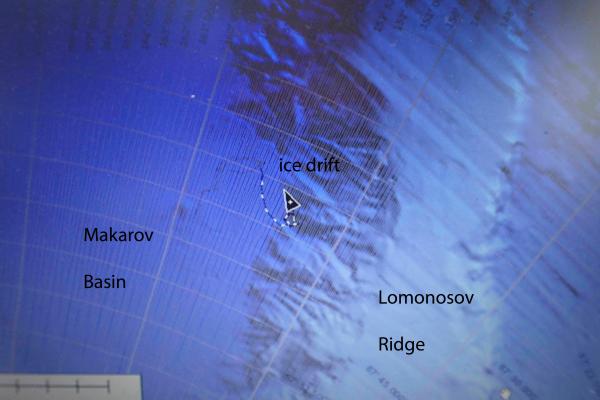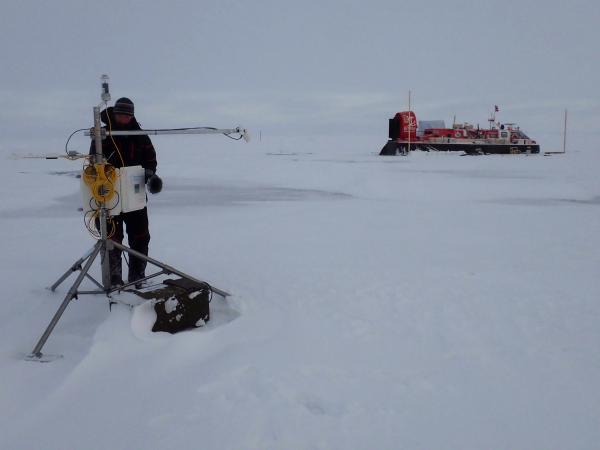(30 Aug. - 7 Sept. 2014)
At 87 20.7' N, 153 58.8' E a large floe next to a lead was spotted from the bridge of the German icebreaking research vessel "Polarstern" in the early morning of Saturday August 30th 2014. The floe was inspected and the thickness found to be about 1.1 meter. The location is within the Transpolar Drift which contains only first year ice and the only thing that will happen is that the ice will get thicker during the coming winter. In terms of the ocean floor landscape, we were in the Makarov Basin at the foot of slope of the Lomonosov Ridge, water depths were about 4.000 meters. The weather conditions were low clouds and poor visibility. Preparation for offloading began at 0800 hours and the hovercraft was put on the ice at 0850 hours. At 1030 hours transfer of diesel from the vessel to fuel bladders on the ice started and the helicopter began moving slings of equipment from the ship to a location on the ice floe about 200 meter from the s hip. The ship's officers, deck and engine crew and all 50 scientist were involved in moving a total of about 7 tons of equipment, food and 14 tons of diesel onto the ice. At 1430 hours, fuel transfer was completed. At a short formal meeting in the Captains quarters at 1530 hours, the Sabvabaa crew, Yngve kristoffersen and Audun Tholfsen signed a paper declearing …they dismiss the Master and Chief Scientist of RV "Polarstern" from their responsibility for the crew and supplies of the hovercraft "Sabvabaa"… and that … "Polarstern" can continue her voyage.
At 1700 hours," Polarstern" left and FRAM-2014/15 was on. The moment was so overwhelming that even after more than six years of preparation, the imminent question came to mind; Now, what do we do? Where do we start? Although the total food supply (18 months) includes plenty of other options, the event was celebrated with a Drytec meal of concentrated food where you just add hot water . A glass of white wine was included.
The activity during the first week has mainly been concerned with getting the camp organized. The fact the icebreaker did not reach its primary target, the Alpha Ridge, has significant implications for FRAM-2014/15. In short; the potential for scientific return (Mesozoic sediments) may appear similar, but the time in the target area is very different. Over Alpha Ridge, there would have been of the order of six months of drift to exploit potential geological sampling locations. Now, the drift upslope of the Lomonosov Ridge may be over in one maximum two months and under challenging visibility conditions. When the large submarine mountain chain is passed, we are out of our prime geological sphere of interest and the rest of the drift over the deep basin and its abyssal plain of turbidites, will be devoted to oceanography and sea ice research.
Since the drift during the first week has kept us at the foot of slope of Lomonosov Ridge, priority has been given to other commitments. These are:
i) setting up and initializing instruments for radiation flux measurements for Met.no.
ii) setting up and initializing a weather station for Geophys. Inst., Univ. of Bergen (GFI)
iii) deploying current meters at 2000 and 800 meter depth from the ice floe for GFI.
iv) testing and deploying five autonomous echo sounder buoys for Blodgett-Hall Polar Presence.
Other oceanographic instrumentation which has been pre-programmed to start logging at 15 September will be deployed next week. These include an acoustic Doppler current profiler to scan ocean currents down to 500 meter water depth and a 300 meter long thermistor string to measure microstructure in the temperature field of halocline layer for estimation of turbulent heat transfer.
Building of the ice/snow hangar is a relatively large undertaking which probably requires one man month of work. This has low priority right now, except for the part which houses the work area for sediment sampling. As of now, one of three walls is up for this section. The technique using a sliding form (glideforskaling) works very well. There is of the order of 10 cm of snow on the ice and we get ice from using a chain saw to cut the surface of refrozen melt ponds which already have 15 cm thick ice on them.
The daily routine involves starting the 4.5 kW generator to charge the batteries and let it run for about one hour five times a day. The hovercraft cabin maintains a comfortable temperature of +18-24 Centigrades using one of its two diesel fired ovens. The extensive on-the-ice experience of Audun Tholfsen and his attitude towards challenges of the frozen earth, are huge assets to the FRAM-2014/15 ice drift. We maintain a Norwegian time schedule even though we are 8 hours ahead in reality. The midnight sun is still with us.
Audun sighted a seal in the lead shortly after "Polarstern" left us. This is the only sign of life so far.
All is well.
Yngve Kristoffersen & Audun Tholfsen
Daily reports
Sunday 31 August.
Position: 87 22' N, 158 10' E , temperature -1 C, air pressure 1010 hPa, white-out conditions except for two hours in the evening. Measured up 3000 m of Kevlar line, marked every 100 meter and spooled on the drum. Organized the camp.
Monday 1 September:
Position: 87 24.3' N, 158 23.5' E, temperature -1 C, air pressure 1014 hPa, wind 8 knots from NNE. White-out, but good visibility for six hours during the late evening. Worked on organizing the camp
Tuesday 2 September:
Position: 87 21.9' N, 158 12.7' E, temperature -4 C, air pressure 1019 hPa, wind 15 knots from NNW. White-out all day. Put up work tent and made a hydro hole for work. Started testing of autonomous buoys at instructions from Woods Hole Oceanographic Institution, USA (WHOI).
Wednsday 3 September:
Position: 87 20.0' N, 157 04' E, temperature -5 C, air pressure 1025 hPa, wind 10 knots from NNW. Measured up and marked 2000 m Kevlar line and deployed a current meter (10909) suspended from the ice at 2000 m depth and another current meter (12313) at 800 meter depth on behalf of Geophysical Institute, Univ. of Bergen.
Thursday 4 September:
Position: 87 21.7 N, 156 36' E, temperature -7 C, air pressure 1024 hPa, wind 12 knots from the East. The drift was 3.6 nautical miles towards NW during the last 24 hours. White- out all day. Deployed the weather station on behalf of Geophysical Institute, Univ. of Bergen and the instruments for incoming and outgoing radiation on behalf of Meteorological Institute. Prepared a hole in the ice for the Acoustic Doppler Current Profiler (ADCP).
Friday 5 September:
Position: 87 23.9' N, 155 48.7' E, temperature - 4 C, air pressure 1019 hPa, wind 5 knots from ESE. White-out all day except for 1.5 hours of useable visibility. Discovered extensive melting under the hull of the hovercraft. Put the craft on pallets to get some distance from the ice surface. Initialized logging at the weather station and the radiation instruments at 0820 GMT. Tests of autonomous echo sounder buoys finalized.
Saturday 6 September:
Position: 87 26.6' N, 155 50' E, temperature - 7 C, air pressure 1007 hPa, wind 19 knots from NNE. Ice drift 0.3 knots towards WNW. At lunch time all of a sudden the sky cleared and we saw the mighty sun from an almost clear sky. This was time for action; all five autonomous echo sounder buoys were deployed within a 6 km radius from the camp on behalf of Blodgett-Hall Polar Presence, the owner of the hovercraft. They will ping every six hours until the end of the FRAM-2014/15 and report the received bottom echo via Iridium to WHOI.
Sunday 7 September:
Position: 87 27.7' N, 152 56.6' E, temperature - 10 C, air pressure 999 hPa, wind 15 knots from W, light snow, water depth 3.800 meter. Our prospective area for geological sampling is to the north and since we are now drifting south, priority is given to work on the ice hangar, particularly the section associated with the work area for sediment coring.
 Screen shot showing the drift track to date in relation to the Lomonosov Ridge submarine topography.
Screen shot showing the drift track to date in relation to the Lomonosov Ridge submarine topography.

Audun Tholfsen initializing the data logger for incoming and outgoing radiation on behalf of the Norwegian Meteorological Institute.
